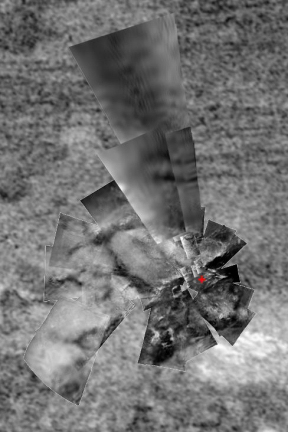Science highlights from Huygens:
# 10. Elusive dunes
| This narrated video shows the view as Huygens descended through the hazy atmosphere to Titan's surface. Credit: ESA/NASA/JPL/University of Arizona. (Click here for further details and larger versions of this video.) |
 |
| Huygens's landing site. Credit: ESA/NASA/JPL-Caltech/ University of Arizona/USGS |
Although the side-looking imager (SLI), part of the Descent Imager/Spectral Radiometer (DISR) on board ESA's Huygens probe, was able to image surface features located up to 450 km from the Huygens landing site, the images it sent back were hard to match with the synthetic aperture radar (SAR) images obtained by the Cassini orbiter.
The area around the Huygens landing site turned out to be a huge plain of dirty water ice over which lay blankets of organic (carbon-bearing) deposits. These mantles of aerosol were invisible to radar waves, so Cassini SAR images only revealed the underlying water ice. As a result, the boundary between the bright highlands and dark plains that Huygens drifted over simply did not show up in the radar images.
The location of the landing site was only tied down after some time by the detection of two dark, longitudinal "sand" dunes, about 30 km north of the landing site. The elusive landforms were visible in both the SAR and Huygens images.
Although dark, longitudinal dunes form vast "sand seas" throughout Titan's optically dark equatorial regions, Huygens descended over a region of bright and dark units that was free of the pervasive dune fields found elsewhere.
The dunes on Titan are probably composed of sand-sized hydrocarbon and/or nitrile grains mixed with lesser amounts of water ice. The particles rained down from above onto the surface and were subsequently eroded and moved by surface and aeolian processes, such as liquid methane runoff and wind erosion.
In order for the sand to migrate across the surface under the influence of Titan's weak surface winds, a process called saltation, scientists have concluded that the dune material must be between 100 microns and 300 microns in diameter.




